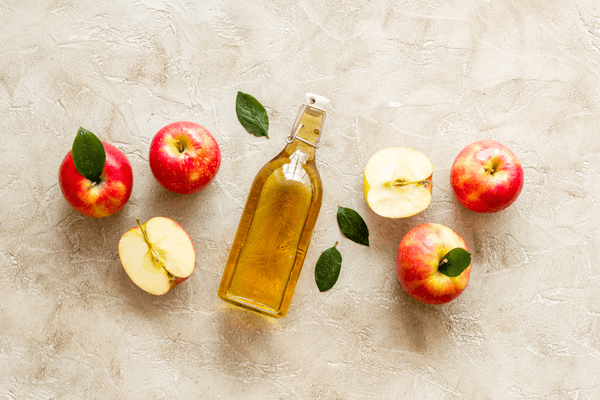What is apple cider vinegar?
Apple cider vinegar (ACV) as the name suggests is a type of vinegar which is made from apple must or cider. It is pale in colour and mildly acidic (5% acetic acid). During the first leg of fermentation, the bacteria and yeast help convert the fruit sugar into ethanol cider. The second fermentation involves the conversion of ethanol into acetic acid.
Uses of ACV
The popularity of ACV has risen especially after the COVID-19 pandemic. However, vinegar has been in use for several decades for culinary use and as a treatment elixir for various conditions due to its easy availability and inexpensive nature. Other types of vinegar which are used diversely based on origin are – Dates, sugarcane, coconut, grapes, plums, rice etc.
- Culinary applications – Salad dressings, marinades, sauces.
- Topical applications – Skin issues (such as acne, eczema, dandruff).
- Medical applications – Dyslipidaemia, obesity, gastric issues, kidney stones, osteoporosis, arthritis, joint pain, blood glucose control, ageing, cognitive decline, and improving athletic performance, immunity etc.
What makes apple cider vinegar special?
The various applications of apple cider vinegar are due to its diverse nutritional properties. In terms of nutrients, ACV contains pectin, B vitamins (vitamin B1, B6, folate, niacin, pantothenic acid), vitamin C, magnesium, potassium etc. The other active components are acetic acid, polyphenolic compounds, probiotics and enzymes.
Here are the beneficial mechanisms induced by ACV:
| Mechanism | Active component of ACV | Mode of action |
| Delayed gastric emptying | Organic acids | When the small intestine is acidic in nature, it helps slow gastric emptying. The acidic nature of the gut stimulates the secretion of a larger number of bicarbonate ions which neutralise the acid and slows gastric emptying. A study observed that ACV slowed gastric emptying by 10% in people with type 1 diabetes mellitus. |
| Helps in glycaemic control | Acetic acid | ACV can suppress the activity of disaccharides such as sucrase, maltase, lactase, trehalase etc. without affecting de novo synthesis of enzymes. |
| Activates AMPK pathway | Acetic acid | ACV can stimulate the AMPK pathway and thereby reduce the level of glucose and lipids in the blood. The AMPK pathway regulates the uptake of glucose and free fatty acid oxidation in the skeletal muscles and other liver mechanisms which will increase the blood glucose and lipid levels. |
| Anti diabetic effect | Organic acid | ACV may improve beta cell function contributing to controlled blood sugar levels. This could be done by reducing inflammation, oxidative stress and lipid profile |
| Anti cancer effect | Polyphenols (procyanidins, flavonoids, epicatechin, catechin) | The polyphenols present in ACV have cytotoxicity effects on human urinary bladder cancer cells |
| Anti-inflammatory | flavonoids | ACV reduced inflammatory markers interleukin 11 and interleukin 2 |
| Reduced cardiotoxicity | Polyphenols | ACV reduces risk of atherosclerosis by: Improving atherogenesis Reducing inflammation and triacylglycerol Reducing arsenic trioxide in the blood Reducing oxidation of LDL cholesterol |
| Anti-oxidant, anti-microbial agent | Polyphenols | ACV increases the antioxidant activity and free radical scavenging activity against E. coli, Staphylococcus aureus and Candida albicans |
| Reduces risk of cognitive impairment | Polyphenols | ACV helps in reduction of age-related depletion of acetylcholine |
Other nutritional and medicinal applications of ACV
- Alzheimer’s disease – ACV contains phenolic compounds such as gallic acid, catechin, caffeic acid, epicatechin, chlorogenic acid and p-coumaric acid which is the reason it is suggested as a functional food in many studies.
In specific, 4-O-methyl honokiol, resveratrol, epigallocatechin-3-gallate (EGCG) may help in providing protection against Azheimer’s disease. Their anti-inflammatory and antioxidant properties help in the intra-cellular signalling process (CREB/ERK pathway) which helps refine human memory.
Adverse effects of ACV
Some individuals who took high quantities of ACV experienced:
- Damage to the oesophagus
- Nausea
- Diarrhoea
- Heartburn
- Damage to the tooth enamel
- Bleaching of teeth
- Hypersensitivity of teeth
- Hypokalemia
- Hyperreninemia
- Osteoporosis
Interactions of ACV
The use of ACV along with hypoglycaemic agents, other drugs and herbal medicines which reduce potassium levels can increase the risk of hypoglycaemia and hypokalemia.
How much ACV is safe to consume?
The quantity of ACV used in most studies does not exceed 30-45mL/day. It is recommended to first consult your doctor and a dietitian to understand the recommended dose and suitability of ACV based on personal medical history. It is best to take ACV as a food additive rather than diluting it in water.
How can you make ACV at home?
If choosing a commercial ACV it is best to buy an ACV with the mother. However, ACV can be made at home easily. Here is the recipe:
Ingredients/materials
- 2 apples
- 1 litre boiled water
- 2 tbsp brown sugar
- 1 clean tall glass jar with lid
- 1 cheesecloth/muslin cloth
- 1 rubber band
Method
- Roughly chop the apples
- Dissolve the sugar in a small bowl of luke warm water and leave it aside.
- Put the apple pieces in the glass jar till half full.
- Pour the sugar solution and water as needed to completely cover the apples.
- Stir with a wooden spoon.
- Cover the bottle with the cloth and rubber band.
- Place the bottle in a cool dry place for 2-3 weeks by stirring with a wooden spoon everyday.
- After 2 weeks a thin white film will be formed on the surface. This is the beginning of the formation of the mother.
- Mix the solution and then strain the liquid out of the bottle.
- Pour the strained liquid alone back into the glass jar and cover with the cloth and rubber band.
- Leave the bottle undisturbed for 4-12 weeks depending on your preferred ACV strength.
- The ACV is ready for use and the mother can be used as the starter culture for a new batch of ACV.
Drawbacks of ACV research
Though most studies on ACV show the health benefits of ACV, there are certain discrepancies which have been noticed:
- There is insufficient information mentioned in the studies regarding the dose, timing of ingestion, duration of study, type of meal consumed.
- Majority of studies conducted are animal studies rather than clinical trials.
- The studies do not conclude on the mechanism behind the therapeutic benefits of ACV.
- The duration of study is a major limit with not many studies being conducted for an extended period of time (more than 12 weeks) to understand the long term effects.
- The nature of most studies on ACV seems to be single blinded.
- The form of ACV used to study benefits varied from pills to its natural form.
Mayuri,
Dietetic Researcher, Simplyweight
- Lipid profile and atherosclerosis – Dyslipidaemia and disorders of lipid metabolism are risk factors of atherosclerosis.
An 8 week study conducted on 19 individuals who took ACV but were never on lipid lowering drugs showed that ACV helped reduce total cholesterol, LDL and triglyceride levels with a mild increase in HDL levels. This could be because of the indirect relationship between flavonoids and serum lipid levels. Flavonoids also have a protective effect on heart related diseases.
- Glycaemic control – Diabetes is a universal endocrine issue affecting most individuals. It is usually a result of impaired insulin secretion, insulin secretion or increased hepatic glucose secretion. ACV is used in glycaemic control since it can:
- Delay gastric emptying
- Suppress absorption of carbohydrates
- Suppress glycogenolysis of the liver
- Improve vaso-dilation
- Increase lipolysis and decreases lipogenesis
- Facilitate better insulin secretion
- Alzheimer’s disease – ACV contains phenolic compounds such as gallic acid, catechin, caffeic acid, epicatechin, chlorogenic acid and p-coumaric acid which is the reason it is suggested as a functional food in many studies.
In specific, 4-O-methyl honokiol, resveratrol, epigallocatechin-3-gallate (EGCG) may help in providing protection against Azheimer’s disease. Their anti-inflammatory and antioxidant properties help in the intra-cellular signalling process (CREB/ERK pathway) which helps refine human memory.
Adverse effects of ACV
Some individuals who took high quantities of ACV experienced:
- Damage to the oesophagus
- Nausea
- Diarrhoea
- Heartburn
- Damage to the tooth enamel
- Bleaching of teeth
- Hypersensitivity of teeth
- Hypokalemia
- Hyperreninemia
- Osteoporosis
Interactions of ACV
The use of ACV along with hypoglycaemic agents, other drugs and herbal medicines which reduce potassium levels can increase the risk of hypoglycaemia and hypokalemia.
How much ACV is safe to consume?
The quantity of ACV used in most studies does not exceed 30-45mL/day. It is recommended to first consult your doctor and a dietitian to understand the recommended dose and suitability of ACV based on personal medical history. It is best to take ACV as a food additive rather than diluting it in water.
How can you make ACV at home?
If choosing a commercial ACV it is best to buy an ACV with the mother. However, ACV can be made at home easily. Here is the recipe:
Ingredients/materials
- 2 apples
- 1 litre boiled water
- 2 tbsp brown sugar
- 1 clean tall glass jar with lid
- 1 cheesecloth/muslin cloth
- 1 rubber band
Method
- Roughly chop the apples
- Dissolve the sugar in a small bowl of luke warm water and leave it aside.
- Put the apple pieces in the glass jar till half full.
- Pour the sugar solution and water as needed to completely cover the apples.
- Stir with a wooden spoon.
- Cover the bottle with the cloth and rubber band.
- Place the bottle in a cool dry place for 2-3 weeks by stirring with a wooden spoon everyday.
- After 2 weeks a thin white film will be formed on the surface. This is the beginning of the formation of the mother.
- Mix the solution and then strain the liquid out of the bottle.
- Pour the strained liquid alone back into the glass jar and cover with the cloth and rubber band.
- Leave the bottle undisturbed for 4-12 weeks depending on your preferred ACV strength.
- The ACV is ready for use and the mother can be used as the starter culture for a new batch of ACV.
Drawbacks of ACV research
Though most studies on ACV show the health benefits of ACV, there are certain discrepancies which have been noticed:
- There is insufficient information mentioned in the studies regarding the dose, timing of ingestion, duration of study, type of meal consumed.
- Majority of studies conducted are animal studies rather than clinical trials.
- The studies do not conclude on the mechanism behind the therapeutic benefits of ACV.
- The duration of study is a major limit with not many studies being conducted for an extended period of time (more than 12 weeks) to understand the long term effects.
- The nature of most studies on ACV seems to be single blinded.
- The form of ACV used to study benefits varied from pills to its natural form.
Mayuri,
Dietetic Researcher, Simplyweight





